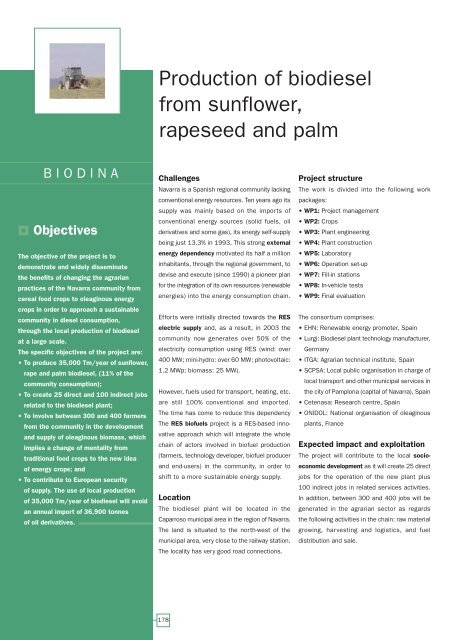European Bio-Energy Projects
European Bio-Energy Projects
European Bio-Energy Projects
Create successful ePaper yourself
Turn your PDF publications into a flip-book with our unique Google optimized e-Paper software.
BIODINA<br />
Objectives<br />
The objective of the project is to<br />
demonstrate and widely disseminate<br />
the benefits of changing the agrarian<br />
practices of the Navarra community from<br />
cereal food crops to oleaginous energy<br />
crops in order to approach a sustainable<br />
community in diesel consumption,<br />
through the local production of biodiesel<br />
at a large scale.<br />
The specific objectives of the project are:<br />
• To produce 35,000 Tm/year of sunflower,<br />
rape and palm biodiesel, (11% of the<br />
community consumption);<br />
• To create 25 direct and 100 indirect jobs<br />
related to the biodiesel plant;<br />
• To involve between 300 and 400 farmers<br />
from the community in the development<br />
and supply of oleaginous biomass, which<br />
implies a change of mentality from<br />
traditional food crops to the new idea<br />
of energy crops; and<br />
• To contribute to <strong>European</strong> security<br />
of supply. The use of local production<br />
of 35,000 Tm/year of biodiesel will avoid<br />
an annual import of 36,900 tonnes<br />
of oil derivatives.<br />
Production of biodiesel<br />
from sunflower,<br />
rapeseed and palm<br />
Challenges<br />
Navarra is a Spanish regional community lacking<br />
conventional energy resources. Ten years ago its<br />
supply was mainly based on the imports of<br />
conventional energy sources (solid fuels, oil<br />
derivatives and some gas), its energy self-supply<br />
being just 13.3% in 1993. This strong external<br />
energy dependency motivated its half a million<br />
inhabitants, through the regional government, to<br />
devise and execute (since 1990) a pioneer plan<br />
for the integration of its own resources (renewable<br />
energies) into the energy consumption chain.<br />
Efforts were initially directed towards the RES<br />
electric supply and, as a result, in 2003 the<br />
community now generates over 50% of the<br />
electricity consumption using RES (wind: over<br />
400 MW; mini-hydro: over 60 MW; photovoltaic:<br />
1.2 MWp; biomass: 25 MW).<br />
However, fuels used for transport, heating, etc.<br />
are still 100% conventional and imported.<br />
The time has come to reduce this dependency<br />
The RES biofuels project is a RES-based innovative<br />
approach which will integrate the whole<br />
chain of actors involved in biofuel production<br />
(farmers, technology developer, biofuel producer<br />
and end-users) in the community, in order to<br />
shift to a more sustainable energy supply.<br />
Location<br />
The biodiesel plant will be located in the<br />
Caparroso municipal area in the region of Navarra.<br />
The land is situated to the north-west of the<br />
municipal area, very close to the railway station.<br />
The locality has very good road connections.<br />
178<br />
Project structure<br />
The work is divided into the following work<br />
packages:<br />
• WP1: Project management<br />
• WP2: Crops<br />
• WP3: Plant engineering<br />
• WP4: Plant construction<br />
• WP5: Laboratory<br />
• WP6: Operation set-up<br />
• WP7: Fill-in stations<br />
• WP8: In-vehicle tests<br />
• WP9: Final evaluation<br />
The consortium comprises:<br />
• EHN: Renewable energy promoter, Spain<br />
• Lurgi: <strong>Bio</strong>diesel plant technology manufacturer,<br />
Germany<br />
• ITGA: Agrarian technical institute, Spain<br />
• SCPSA: Local public organisation in charge of<br />
local transport and other municipal services in<br />
the city of Pamplona (capital of Navarra), Spain<br />
• Cetenasa: Research centre, Spain<br />
• ONIDOL: National organisation of oleaginous<br />
plants, France<br />
Expected impact and exploitation<br />
The project will contribute to the local socioeconomic<br />
development as it will create 25 direct<br />
jobs for the operation of the new plant plus<br />
100 indirect jobs in related services activities.<br />
In addition, between 300 and 400 jobs will be<br />
generated in the agrarian sector as regards<br />
the following activities in the chain: raw material<br />
growing, harvesting and logistics, and fuel<br />
distribution and sale.

















